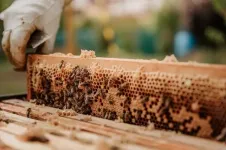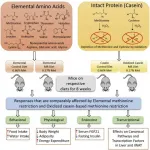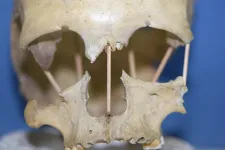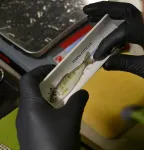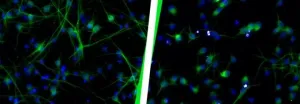(Press-News.org) The University of Maryland (UMD) co-published a new review paper in the Annual Review of Resource Economics to examine pollinators from both an economic and ecological perspective, providing much needed insight into the complexities of valuing pollination. Pollinators are not only a critical component of a healthy ecosystem, but they are also necessary to produce certain foods and boost crop yields. While native and wild pollinators (whether they be certain bee species, other insects and animals, or just the wind) still play an important role, managed honey bee colonies are commercially trucked around the U.S. to meet the need for pollination services in agricultural products. Recent reports of parasites, disease, and other concerns in colonies call into question the resilience of the managed honey bee rental markets, as well as how those managed bees are interacting with native pollinators. This recent collaboration with the University of California, Santa Barbara (UCSB), and the University of North Texas (UNT) highlights the importance of characterizing the economic value of pollination services, including that of managed and wild pollinators, both for the sustainability of honey bee markets and the protection of overall ecosystem health.
"Many people don't realize that honey bees are not native to the U.S., or that they are actually a form of agricultural livestock rented out largely for their pollination services," says Erik Lichtenberg, professor in Agricultural and Resource Economics at UMD. "It used to be that you raised bees for honey, but today, pollination services account for the largest share of commercial beekeeper income, with honey as a secondary product. Agriculture is always integrated into an ecosystem, and we typically think about the managed parts without the ecosystem parts. But when we are thinking about resilience and things like climate change which is changing the ecosystem, then we have to reckon with the parts that we've tended to ignore. Getting a more holistic sense of the health of pollinators and the true resilience of the rental market is very important."
Researchers have historically struggled to put a value on pollination services, largely because of the many complex inputs into the system like wind, native versus managed pollinator interactions, weather, and even quality or health of the bees due to emerging diseases and invasive pests like varroa mites -- in addition to inputs provided by farmers. With these complexities in mind, Erik Lichtenberg teamed up with Kathy Baylis, economist and professor in geography at UCSB, and Elinor Lichtenberg, ecology professor at UNT, to take an interdisciplinary approach to reviewing the economics of pollination.
"As a pollination ecologist, it was exciting to collaborate with economists to write this review," says Elinor Lichtenberg. "One of our goals was to help ecologists understand the economics, and economists understand the ecological considerations and constraints involved. This will help develop solutions that benefit both wildlife and farmers."
Elinor Lichtenberg did her undergraduate work in biology at UMD, also spending a year working with Daniel Gruner and Dennis vanEngelsdorp in Entomology. Baylis also collaborates with vanEngelsdorp and the Bee Informed Partnership (BIP), a UMD-led nonprofit organization that conducts a nationwide annual survey each year since 2006 to assess managed honey bee health and colony loss.
"Colony collapse disorder was big in the media in 2006 when beekeepers started seeing so many of their bees dying, so people wanted to know why," explains Baylis. "With our increased reliance on managed honey bees for pollination, it really raised concerns about the resilience of the system we have in place, or the lack thereof. As it turns out, the pollination market and associated fees are quite responsive to colony health, and beekeepers have been able to meet that demand so far. The price signals are working, but there are many things that aren't really priced in yet. So a big part of this paper is to highlight the linkages where we know things are being captured, and the values that aren't being captured but should be."
Erik Lichtenberg adds, "If we are thinking about the resilience of the system of migratory managed pollination services, a lot of that system is still hidden. We see the tip of the iceberg, but we don't see what is underneath the waterline, so we'd like to take our analytical submarine and check out what's down there."
Currently, the system involves a migration route that is similar to that of farmed labor. Managed honey bee colonies start their year in central California pollinating almonds, plums, prunes, and other early blooming crops, and then are transported slowly up north to later blooming crops like apples, cucumbers, squash, and even pumpkins. The route moves up to the Pacific Northwest and then ends with the bees "summering" in the Northern Plains region to forage and recharge. This system has become increasingly important as agriculture has become more specialized and mechanized, with less habitat for native pollinators and more consumer demand for insect-pollinated crops. But, as the researchers explain, there is so much about the system we just don't understand.
"When problems like colony collapse disorder arise, to me, it feels like we are always trying to attach band aids to different parts of the dike wherever we see a crack without seeing the whole necessarily," says Baylis. "And that's a big purpose of the paper is trying to at least sketch out what the whole thing might look like."
Some of the biggest unknowns identified are the protection of forage lands and habitat for native and managed honey bee colonies, how to manage the surrounding landscape to optimize pollination services and pollinator health, and especially understanding the interactions between wild and managed pollinators. Interactions may be positive, as with native pollinators reaching higher branches in high winds while honey bees stick to lower branches, or they can be negative, like the spread of disease from managed to wild pollinators. All these inputs are especially important when considering the costs and benefits of conserving wild pollinator habitat.
"Economists and ecologists both recognize the importance of putting an economic value on inputs like clean water, clean air, biodiversity, and natural pollination, because these natural products that aren't bought and sold in the market otherwise get a default value of zero placed on them," says Baylis. "We know that is wrong, so hopefully this can draw attention to that issue. We've identified a lot of gaps here, and it is important not just for the space of bees, but more broadly for issues where part of the ecological system is managed and monetized, and other parts are not. This speaks to how we can develop a system that is responsive, resilient, and also sustainable."
Erik Lichtenberg adds, "We are excited about the follow-on work that we've identified to do. There is a lot of fascinating work to be done in this area, and we hope this review inspires people to think creatively about some of the issues we've raised."
INFORMATION:
This paper, entitled "Economics of Pollination," is published in the Annual Review of Resource Economics, DOI: 10.1146/annurev-resource-101420-110406.
BATON ROUGE, Louisiana - A diet that improves the biomarkers of metabolic health, and that could potentially slow the aging process, has moved a step closer to reality.
"We've known for years that restricting the amino acid methionine in the diet produces immediate and lasting improvements in nearly every biomarker of metabolic health," said Thomas W. Gettys, PhD, Professor and Director, Nutrient Sensing and Adipocyte Signaling Laboratory at Pennington Biomedical Research Center. "The problem is that methionine-restricted diets have been difficult to implement because they taste so bad."
Until now. Restricting methionine normally involves diets formulated with elemental (e.g., individual) amino acids. Individual amino acids are the building blocks ...
May 20, 2021 - Women with a history of weight cycling - losing and regaining 10 pounds or more, even once - have increased rates of insomnia and other sleep problems, reports a study in The Journal of Cardiovascular Nursing, official journal of the Preventive Cardiovascular Nurses Association. The journal is published in the Lippincott portfolio by Wolters Kluwer.
"History of weight cycling was prospectively associated with several measures of poor sleep, including short sleep duration, worse sleep quality, greater insomnia, greater sleep disturbances, ...
Melting glaciers and polar ice sheets are among the dominant sources of sea-level rise, yet until now, the water beneath them has remained hidden from airborne ice-penetrating radar.
With the detection of groundwater beneath Hiawatha Glacier in Greenland, researchers have opened the possibility that water can be identified under other glaciers from the air at a continental scale and help improve sea-level rise projections. The presence of water beneath ice sheets is a critical component currently missing from glacial melt scenarios that may greatly impact how quickly seas rise - for example, by enabling big chunks of ice to calve ...
New research led by the University of Kent's School of Psychology has found that some brain activity methods used to detect incriminating memories do not work accurately in older adults.
Findings show that concealed information tests relying on electrical activity of the brain (electroencephalography [EEG]) are ineffective in older adults because of changes to recognition-related brain activity that occurs with aging.
EEG-based forensic memory detection is based on the logic that guilty suspects will hold incriminating knowledge about crimes they have committed, and therefore their brains will elicit a recognition response ...
For the first time, researchers have successfully sequenced the entire genome from the skull of Peştera Muierii 1, a woman who lived in today's Romania 35,000 years ago. Her high genetic diversity shows that the out of Africa migration was not the great bottleneck in human development but rather this occurred during and after the most recent Ice Age. This is the finding of a new study led by Mattias Jakobsson at Uppsala University and being published in Current Biology.
"She is a bit more like modern-day Europeans than the individuals in Europe 5,000 years earlier, but the difference is much less than we had thought. We can see that she is not a direct ancestor of modern Europeans, but she is a predecessor of the hunter-gathers that lived in Europe until the end of the last ...
DURHAM, N.C. - A newly identified group of antibodies that binds to a coating of sugars on the outer shell of HIV is effective in neutralizing the virus and points to a novel vaccine approach that could also potentially be used against SARS-CoV-2 and fungal pathogens, researchers at the Duke Human Vaccine Institute report.
In a study appearing online May 20 in the journal Cell, the researchers describe an immune cell found in both monkeys and humans that produces a unique type of anti-glycan antibody. This newly described antibody has the ability to attach ...
Juvenile salmon migrating to the sea in the Sacramento River face a gauntlet of hazards in an environment drastically modified by humans, especially with respect to historical patterns of stream flow. Many studies have shown that survival rates of juvenile salmon improve as the amount of water flowing downstream increases, but "more is better" is not a useful guideline for agencies managing competing demands for the available water.
Now fisheries scientists have identified key thresholds in the relationship between stream flow and salmon survival that can serve as actionable targets for managing water resources in the Sacramento River. The new analysis, published May 19 in Ecosphere, revealed nonlinear ...
Today, proteins that can be controlled with light are a widely used tool in research to specifically switch certain functions on and off in living organisms. Channelrhodopsins are often used for the technique known as optogenetics: When exposed to light, these proteins open a pore in the cell membrane through which ions can flow in; this is how nerve cells can be activated. A team from the Centre for Protein Diagnostics (PRODI) at Ruhr-Universität Bochum has now used spectroscopy to discover a universal functional mechanism of channelrhodopsins that determines their efficiency as a channel and thus as an optogenetic tool. The researchers led by Professor Klaus ...
Microfluidic technologies have seen great advances over the past few decades in addressing applications such as biochemical analysis, pharmaceutical development, and point-of-care diagnostics. Miniaturization of biochemical operations performed on lab-on-a-chip microfluidic platforms benefit from reduced sample, reagent, and waste volumes, as well as increased parallelization and automation. This allows for more cost-effective operations along with higher throughput and sensitivity for faster and more efficient sample analysis and detection.
Optoelectrowetting (OEW) is a digital optofluidic technology that is based on the principles of light-controlled electrowetting and enables ...
Since our ancestors infected themselves with retroviruses millions of years ago, we have carried elements of these viruses in our genes - known as human endogenous retroviruses, or HERVs for short. These viral elements have lost their ability to replicate and infect during evolution, but are an integral part of our genetic makeup. In fact, humans possess five times more HERVs in non-coding parts than coding genes. So far, strong focus has been devoted to the correlation of HERVs and the onset or progression of diseases. This is why HERV expression has been studied in samples of pathological origin. Although important, these studies ...
